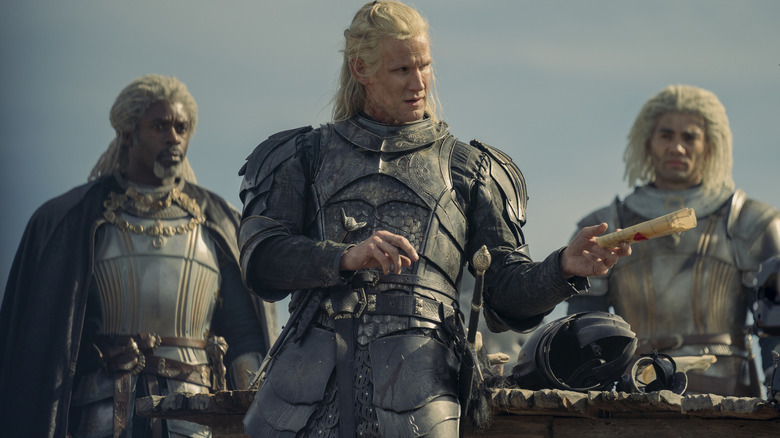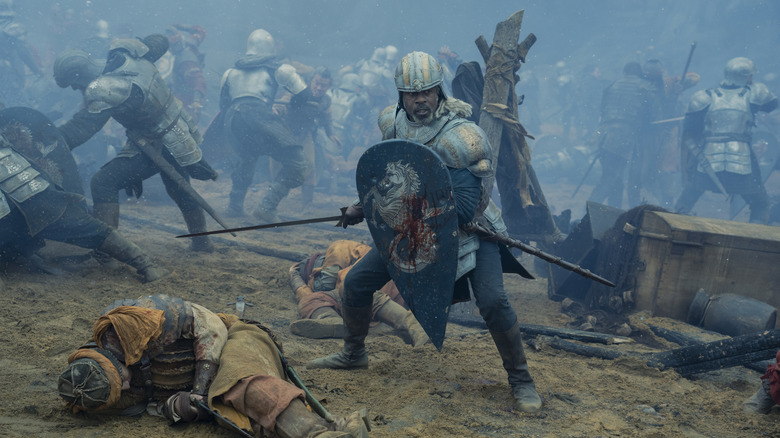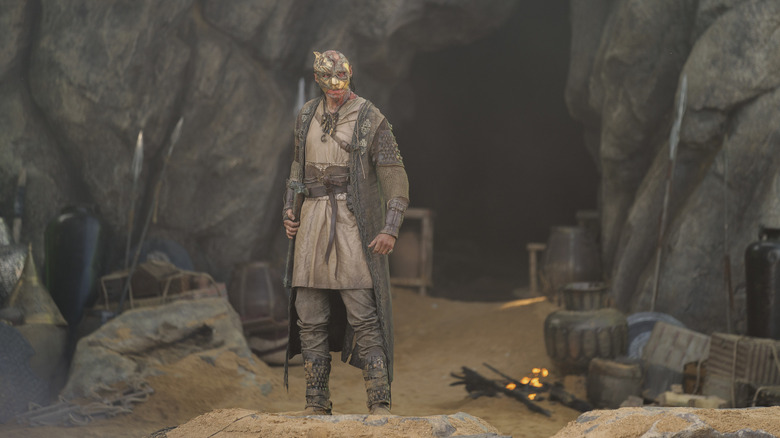House Of The Dragon: The War For The Stepstones Explained
Nobody would accuse "House of the Dragon" of lacking in spectacle or tension thus far, but one thing the show has been missing until this point would have to be the massive, cinematic battle sequences that "Game of Thrones" turned into its bread and butter. But episode three of the prequel series finally unlocked the shackles and plunged Westeros into full-fledged war ... even if it isn't the war that viewers have been waiting to erupt from within the Targaryen family, steadily building since the opening prologue of the very first episode. But before we get there, "House of the Dragon" served up a violent appetizer thanks to the headstrong and utterly reckless Daemon Targaryen (Matt Smith) launching his own offensive in the distant Stepstones, waging an unsanctioned war along with Corlys Velaryon (Steven Touissant) against the sinister Crabfeeder (Daniel Scott-Smith).
With so much going on in the series, however, co-creator Ryan Condal and the writing team have been forced to condense and streamline major events that author (and series co-creator) George R.R. Martin set down in his fictionalized historical novel, "Fire & Blood." One such victim of this adaptation choice is the War for the Stepstones, a conflict that has been seeded throughout the series since the very first small council scene in the premiere episode, which might leave viewers a little confused about what's actually going on.
Luckily, Martin is nothing if not a fastidious, detail-oriented writer — trust me, those of us foolish enough to still hold out hope that he'll finish writing "The Winds of Winter" know this all too well — and he made sure to include plenty of backstory and political motivations when describing the situation on the island chain known as the Stepstones, the rise of the Crabfeeder, and the strain this causes on King Viserys' (Paddy Considine) rulership. For those obsessed with the nerdiest details of worldbuilding but without the time to dig into the source material itself, here's everything you need to know about the War for the Stepstones.
Spoilers for the latest episode of "House of the Dragon" follow.
Just a (step)stone's throw away...
Folks, class is now in session and I'll need everyone to take out their official maps of Westeros. For those who forgot their copy (there's always a few, you know who you are!), feel free to check out this interactive map of Martin's fantasy world to help orient yourselves. I warn you, though: We're about to get really nerdy here.
Like every ruler since the days of Aegon the Conqueror, the Targaryen invader who first crossed the Narrow Sea and united the Seven Kingdoms of Westeros into one, King Viserys rules from the Iron Throne in King's Landing. Far to the south, however, his largely peaceful rule was complicated by war among the Free Cities of Lys, Myr, and Tyrosh (the rulers of whom are called the Triarchs) — cities that we saw Emilia Clarke's Daenerys Targaryen attempt to liberate (or, in effect, conquer) during the latter seasons of "Game of Thrones" – against the rival Volantis. After driving the Volantenes from their land, the Triarchs attempted to flaunt their unified power and make their most daring move yet. Ideally located in a key trading route in the Narrow Sea separating Westeros from its sister continent Essos, the Stepstones provide a crucial economic advantage to anyone who may control the scattered islands.
Martin describes Westeros as initially accepting of this new change in the balance of power, as the Triarchs' more orderly rule replaced the pirates, thieves, and other violent criminals who previously called those islands their home. But once the greedy Triarchs continued to raise tolls for any trades ships passing by the Stepstones, to the point of bankrupting merchants who dared venture through their waters, sentiment began to change — particularly among House Velaryon, the wealthy sailors most affected by this farce.
Feeling crabby
Enter Craghas Drahar, the brutal Myrish prince admiral leading the Triarch fleets onto the Stepstones who soon became known as Craghas Crabfeeder for his, uh, imaginative method of putting captured pirates out of their misery. "House of the Dragon" takes a slightly different approach to this individual, rendering him as battle-scarred and non-verbal (whether by choice or as a fighting injury, we never find out) holding sway over the Stepstones with his ragtag followers. This is the context that preceded that secretive meeting between the Sea Snake and Daemon that concluded episode two, an alliance forged in mutual dismay over Viserys' leadership decisions. Episode three, set several years later, explores the political machinations involved in why the crown can't be seen to publicly support his brother's aggression — which would be interpreted as an act of war on all the powerful Free Cities.
Fascinatingly enough, "House of the Dragon" has taken liberties with the source material in adapting these events, and to thrilling results. All this lore is explained in a mere couple of pages in "Fire & Blood," including the glossed-over details of Daemon challenging the Crabfeeder to one-on-one combat and essentially ending the war after cutting him in half, but the HBO series is obligated to stretch out this material to form the backbone of an entire episode of story. Thankfully, the writers found a perfectly in-character way to bring this storyline to life, giving the hotheaded Daemon just cause to reject his brothers' well-meaning aid and take on the Crabfeeder's forces almost singlehandedly.
"House of the Dragon" continues to flesh out the purposefully vague and ambiguous details recorded in "Fire & Blood," and the War for the Stepstones may be the show's best moment yet. The fallout will undoubtedly come next Sunday night in episode four.


